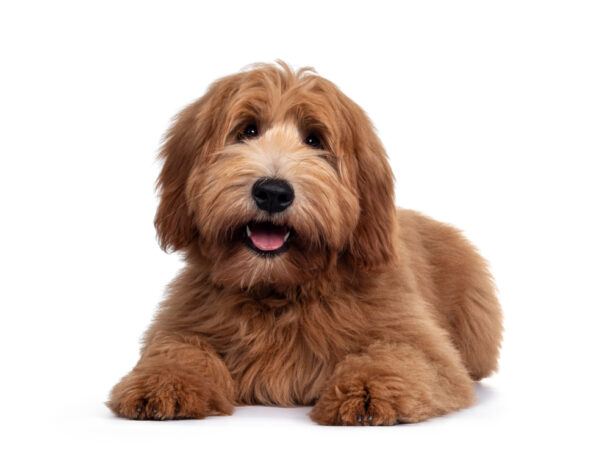LifeWithMyDogs is supported by our audience. When you purchase through one of our links, we may earn a small affiliate commission. As an Amazon Associate I earn from qualifying purchases. Your cost is not affected.
**********
Hey there, fellow dog lovers! Are you tired of finding fur tumbleweeds all over your house? Well, you’re not alone. Dog excessive shedding can turn your cozy home into a furry frenzy, but don’t pull your hair out yet!
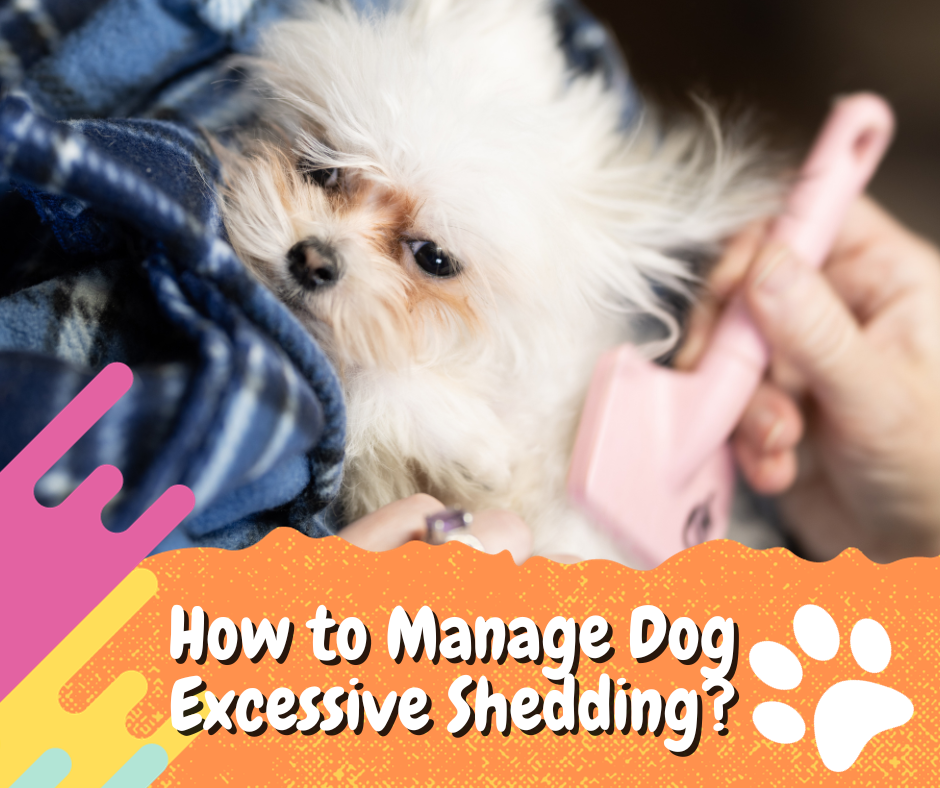
In this blog post, we’re diving deep into dog shedding to uncover why your pup seems to be on a never-ending quest to spread fur far and wide. But don’t worry, we won’t leave you hanging with the problem. We have a treasure trove of tips and tricks to help you regain control over your home and keep your four-legged friend looking fabulous.
We’re not just going to leave you with a head full of knowledge. We’ll equip you with practical, easy-to-follow solutions to make your home a fur-free paradise. Ready to embark on this journey to a less hairy life?
Let’s dive in!
Understanding Excessive Shedding in Dogs
Shedding is a natural process for dogs to get rid of old, damaged, or unnecessary fur, helping them maintain a healthy dog’s coat and regulate body temperature. Most dogs shed more during spring and fall, but some breeds are genetically predisposed to dog shedding more than others, especially if they live primarily indoors. Understanding your dog’s shedding patterns can help you better manage their fur and maintain a clean home environment.
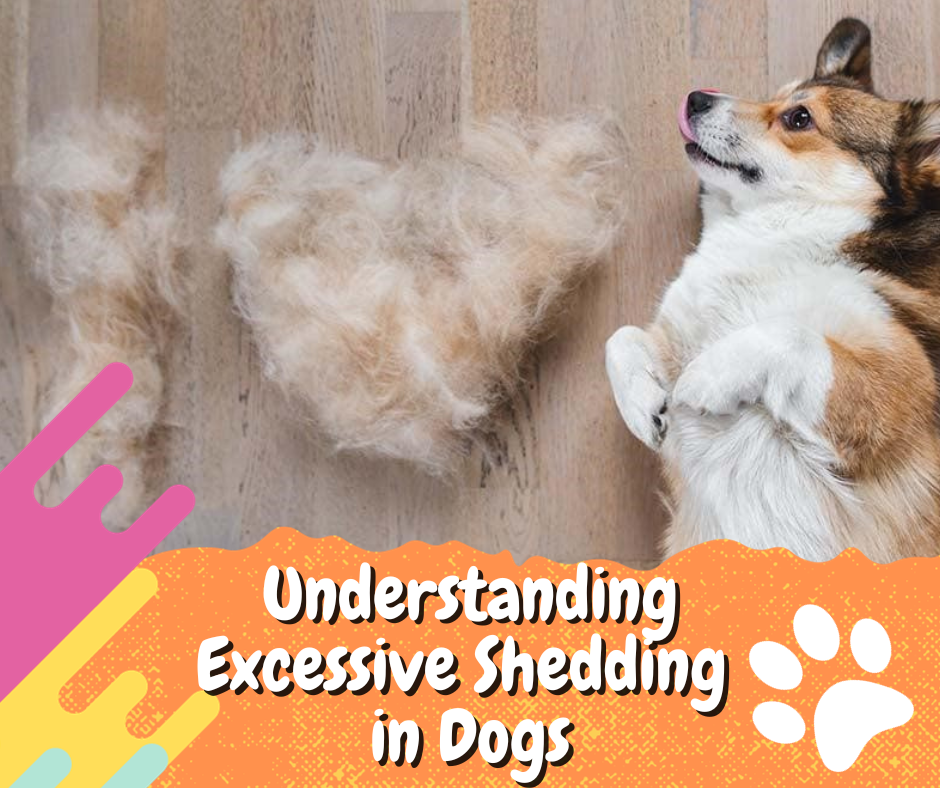
However, excessive shedding goes beyond the regular fur loss and can concern pet owners. It’s essential to distinguish between normal shedding and a pet’s excessive shedding. Steady shedding is typical, but if you start to see:
- Bald patches
- Red or irritated skin
- Excessive scratching or licking
- Changes in appetite or behavior
It could be a sign of excessive hair loss, which may indicate excessive shedding and an underlying medical condition, such as fungal infections.
Common Causes of Excessive Shedding
Several factors can contribute to excessive shedding in dogs, including:
- Seasonal changes
- Poor nutrition
- Stress
- Underlying health issues
Dogs typically shed more during spring and fall as their coats adjust to the changing temperatures. Poor nutrition can also lead to excessive shedding, affecting your pet’s skin and coat health. Additionally, allergies can cause skin irritation, inflammation, and fur loss.
Identifying the underlying cause of your pet’s excessive shedding is critical to managing it properly. Regular vet check-ups can help monitor your pet’s overall health, and maintaining a clean and comfortable home environment can help reduce stress-induced shedding.
Recognizing Abnormal Shedding
Symptoms like bald patches, excessive itching, and skin irritation may indicate abnormal shedding. If your dog’s shedding is more than usual, it’s essential to consult a veterinarian, as it could be a sign of an underlying medical condition.
In addition to bald patches, other symptoms of abnormal shedding include intense itching, skin redness, and irritation. Monitoring your dog’s health and seeking veterinary advice if these symptoms persist for over a week is crucial. Early intervention can help address medical issues and ensure your pet’s well-being.
Tips for Reducing Excessive Shedding
Proper nutrition, grooming, and skincare can help reduce excessive shedding in dogs and improve their overall coat health. Here are some tips to follow:
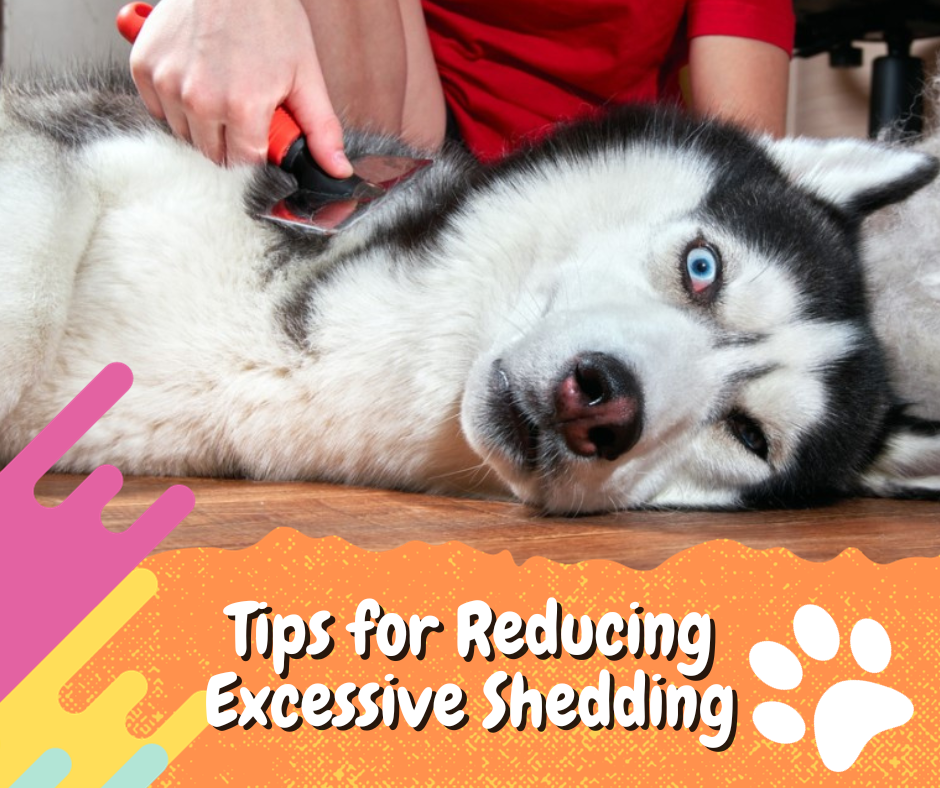
- Provide a well-balanced diet for your dog.
- Regularly brush your dog’s coat to remove loose hair.
- Use the right skincare products for your dog’s specific needs. By following these tips, you can help maintain a healthy and shiny coat for your pet, making them look and feel their best.
By understanding your dog’s needs and providing them with the best care, you can keep their coat healthy and reduce the amount of fur floating around your home.
Proper Nutrition and Supplements
Feeding your dog a balanced diet rich in essential nutrients and supplements plays a significant role in maintaining a healthy coat and reducing shedding. Omega-3 and omega-6 fatty acids are particularly beneficial for your pup’s skin, as they help keep it hydrated and reduce inflammation from inflammatory skin conditions. Foods naturally high in omega-3 and omega-6 for dogs include:
- Vegetable oils
- Chicken and animal fats
- Fish oil
- Green-lipped mussel oil
- Hempseed oil
- Whole fish
- Flaxseed
Before adding omega fatty acid supplements to your dog’s diet, remember to seek advice from your veterinarian or select a supplement designed specifically for dogs.
A well-rounded dog’s diet and proper grooming and skincare practices can significantly reduce excessive shedding and promote healthy hair growth, keeping your pet looking and feeling great. On the other hand, a poor diet may lead to the opposite effect.
Regular Grooming and Brushing
Regular grooming and brushing can help remove dead hair and prevent matting while promoting healthy skin and coat. Brushing your dog’s coat regularly helps remove loose hair and stimulates natural oil production, hydrating the skin and improving coat health. During peak shedding seasons, like spring and fall, more frequent brushing may be needed to keep up with the loose pet hair.
Choosing the right brush for your dog’s coat type is essential. Here are some recommendations:
- For short or wiry coats, use a bristle brush.
- For long and silky-haired dogs, a pin brush is best.
- For double or heavy coats, an undercoat rake works excellently.
Regular grooming helps reduce shedding and keeps your dog looking their best.
Bathing and Skin Care
Bathing your dog with appropriate shampoos and frequency can help remove dead hair and maintain healthy skin, reducing excessive shedding. A monthly bath is sufficient for most dogs to keep their coat clean and healthy. However, during peak shedding seasons, you may need to bathe your dog more frequently to remove dead hair before it falls out.
When selecting a shampoo, opt for de-shedding shampoos like:
- Arm & Hammer’s Ultra Fresh Shed Control Dog Shampoo
- The Coat Handler Undercoat Control Deshedding Dog Shampoo
- TropiClean Lime & Coconut Deshedding Dog Shampoo
These shampoos help control shedding and moisturize the skin and coat. A clean and well-groomed dog is a happy dog – and a less furry home for you!
Video Credit: @VeterinarySecrets
Medical Conditions That Cause Excessive Shedding
Certain medical conditions, such as allergies and hormonal imbalances, can cause excessive shedding in dogs and may require veterinary intervention. Allergies to food, medication, or environmental factors can cause skin irritation and excessive shedding, which may require treatment or dietary changes.
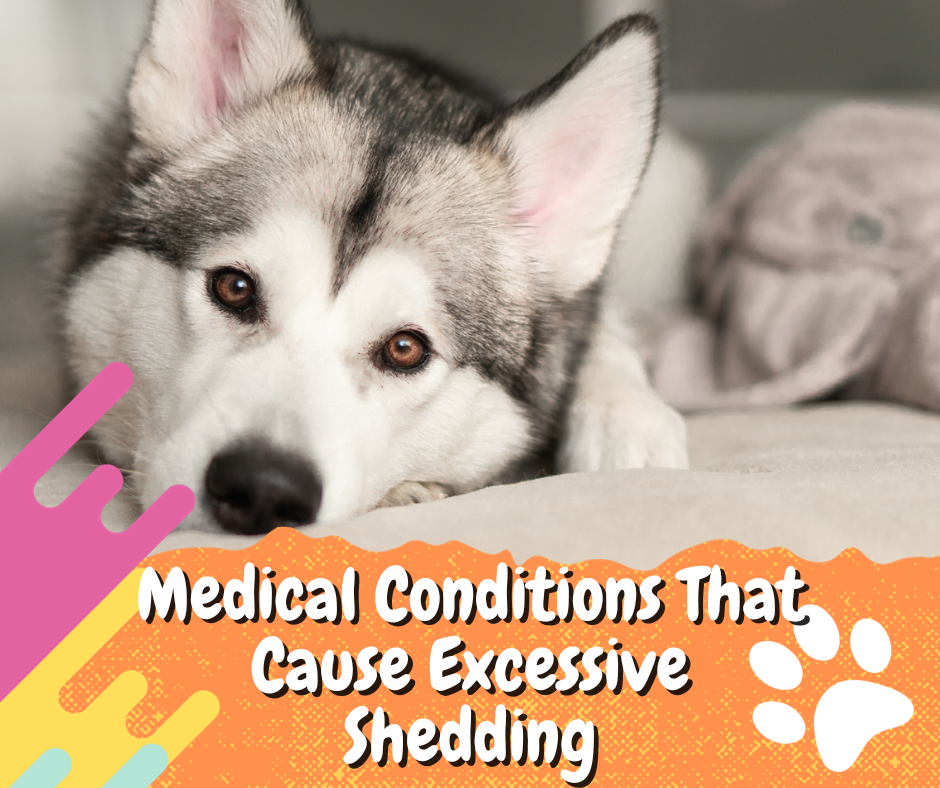
Hormonal imbalances and internal issues, such as thyroid or adrenal diseases, can also lead to excessive shedding. Let’s explore these medical conditions and discuss how they impact your dog’s shedding. Understanding the root cause of excessive shedding is vital to managing it effectively and ensuring your pet’s overall health.
Allergies and Skin Irritations
Allergies can cause skin irritation and excessive shedding in dogs. Food allergies can lead to skin irritations, inflammation, and fur loss, triggering an immune response that affects the dog’s skin and coat. Environmental factors, such as pollens, dust and dust mites, and mold, can cause allergies or skin irritation to your pup.
If you suspect your dog has allergies, it’s essential to consult your veterinarian for proper diagnosis and treatment. This may include anti-inflammatory medications, medicated baths, or even dietary changes to eliminate the allergens causing the reaction.
Addressing your dog’s allergies can help reduce excessive shedding and improve their quality of life.
Hormonal Imbalances and Internal Issues
Hormonal imbalances and internal issues, such as thyroid or adrenal diseases, can cause excessive shedding in dogs. Conditions like hypothyroidism and hyperadrenocorticism can cause hair loss and thickened skin, leading to excessive shedding. There’s also Alopecia X, a sex hormone imbalance that can cause hair loss in certain breeds.
If you suspect your dog has a hormonal imbalance or internal issue causing excessive shedding, it’s crucial to consult your veterinarian for proper diagnosis and treatment. This may include prescription medications, supplements, or topical treatments to stimulate hair follicles and reduce shedding.
Early intervention is vital to ensure your pet’s overall well-being and manage excessive shedding effectively.
Breed-Specific Shedding Considerations
Different dog breeds have varying shedding tendencies, with some breeds being heavy shedders and others being low-shedding breeds. Heavy-shedding breeds, such as German Shepherds and Siberian Huskies, may require more frequent grooming and attention to manage shedding effectively. On the other hand, low-shedding breeds, like Poodles and Maltese, may still require regular grooming to maintain a healthy coat and prevent matting.
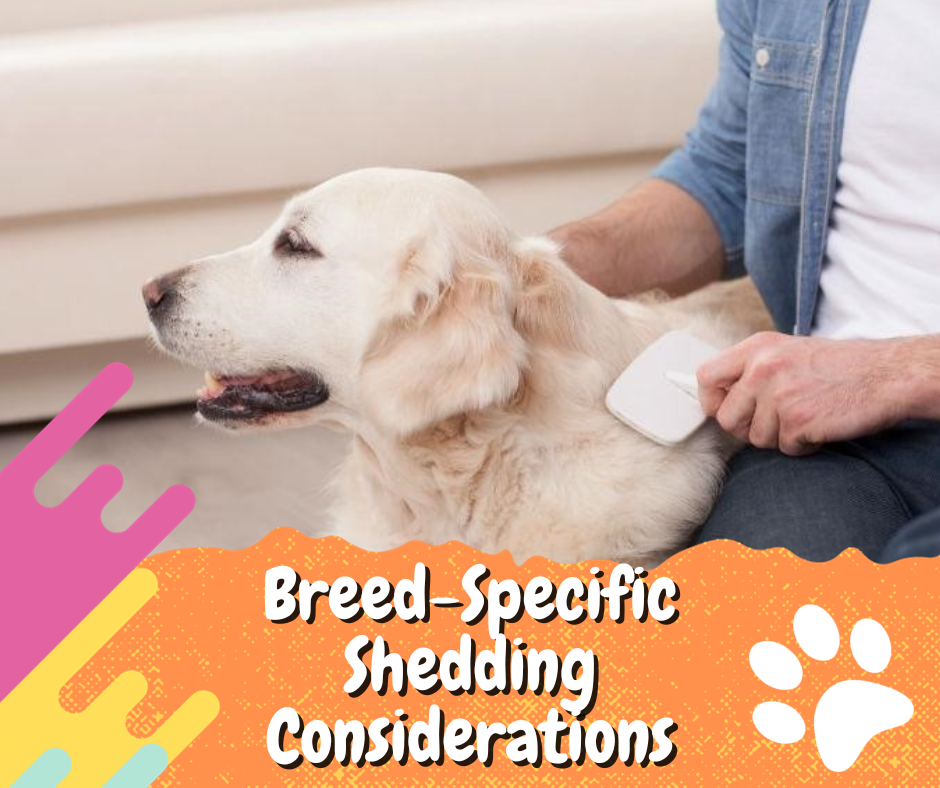
Let’s examine the grooming requirements of both heavy- and low-shedding breeds in more detail. By understanding your dog’s breed-specific shedding tendencies, you can tailor your care routine to effectively manage shedding and maintain a healthy coat.
Heavy-Shedding Breeds
Heavy-shedding breeds, such as:
- German Shepherds
- Siberian Huskies
- Golden Retrievers
- Labrador Retrievers
- Alaskan Malamutes
It may require more frequent grooming and attention to manage shedding effectively. These breeds typically have double coats or long hair, making them prone to shedding more than other breeds.
Frequent grooming is recommended for heavy-shedding dog breeds, with more frequent brushing and combing during shedding periods. The frequency can vary from daily to weekly or monthly, depending on the dog. However, it’s essential not to bathe them too often, as it can strip away the protective oils from their coats. For more specific guidance, consult your veterinarian or professional groomer, who can advise based on your dog’s needs.
Low-Shedding Breeds
Low-shedding breeds, such as Poodles, Maltese, and Shih Tzus, have coat types that require regular grooming to maintain a healthy coat and prevent matting. Although these breeds shed less, they still need proper care to ensure their coat remains healthy and manageable.
Low-shedding dog breeds should be groomed every 4-6 weeks, but it’s essential to consult your veterinarian for the recommended frequency depending on the breed and coat type. Regular grooming, a balanced diet, and appropriate skincare can help maintain a healthy coat and minimize shedding in these breeds.
Proper Nutrition and Supplements
Feeding your dog a balanced diet rich in essential nutrients and supplements plays a significant role in maintaining a healthy coat and reducing shedding. Omega-3 and omega-6 fatty acids are particularly beneficial for your pup’s skin, as they help keep it hydrated and reduce inflammation from inflammatory skin conditions. Foods naturally high in omega-3 and omega-6 for dogs include:
- Vegetable oils
- Chicken and animal fats
- Fish oil
- Green-lipped mussel oil
- Hempseed oil
- Whole fish
- Flaxseed
Before adding omega fatty acid supplements to your dog’s diet, remember to seek advice from your veterinarian or select a supplement designed specifically for dogs.
A well-rounded dog’s diet and proper grooming and skincare practices can significantly reduce excessive shedding and promote healthy hair growth, keeping your pet looking and feeling great. On the other hand, a poor diet may lead to the opposite effect.
Creating a Shedding-Friendly Home Environment
Creating a shedding-friendly home environment can help pet owners manage excessive shedding and reduce allergens. Regular cleaning and vacuuming help remove pet hair and dander, while specialized cleaning tools and devices can make the process more efficient.
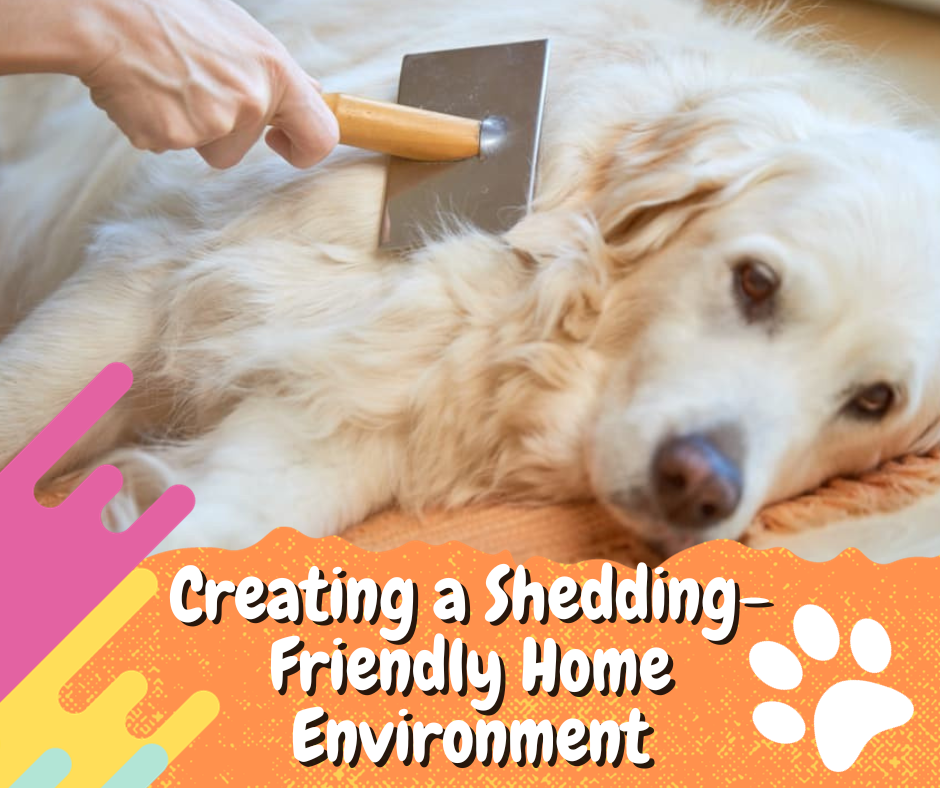
Additionally, managing allergies in the household may involve using air purifiers, hypoallergenic bedding, and regular cleaning to reduce allergens and maintain a comfortable living environment.
Cleaning and Vacuuming Techniques
Regular cleaning and vacuuming can help remove pet hair and dander, while specialized cleaning tools and devices can make the process more efficient. Vacuuming once or twice a week is recommended to keep the dog hair under control in your home. During peak shedding seasons, like spring and fall, you may need to vacuum more often, even daily.
Some of the top vacuum cleaners for pet hair removal include:
- Bissell Pet Hair Eraser Turbo Plus Lightweight Vacuum
- Dyson V15 Detect
- Samsung Jet 75 Pet
- Shark Navigator Zero-M Self-Cleaning Brushroll Pet Pro
- Tineco Pure One S11 Cordless Vacuum Cleaner
- Dyson Ball Animal
- Miele Complete C3
Regular cleaning helps manage pet hair and contributes to a cleaner and healthier living environment for you and your pet.
Allergy Management Tips
Managing allergies in the household may involve:
- Using air purifiers to cut down on allergens in the air
- Using hypoallergenic bedding to reduce allergens on the bed
- Regular cleaning to reduce allergens and maintain a comfortable living environment.
In addition to using air purifiers and hypoallergenic bedding, cleaning your home regularly to reduce allergens and maintain a comfortable living environment is crucial. This includes vacuuming, dusting, and washing bedding and curtains to minimize allergens in your home, such as dust mites and pet dander.
These allergy management tips can create a healthier and more comfortable living environment for you and your pet.
Conquer Dog Shedding!
Yes, I understand buddy. We both know that dealing with your dog’s shedding can be a real challenge for pet owners. But don’t worry! There are ways to tackle it while keeping your furry buddy’s coat in tip-top shape. Things like ensuring they’re eating right, giving them regular grooming sessions, and taking care of their skin can all help cut down on that pesky shedding. Also, understanding your dog’s breed-specific shedding tendencies can be a game-changer when tailoring your care routine.
Taking a proactive approach to managing all that hair can lead to a happier, healthier pet and a cleaner home. With the right knowledge and tools, you can handle excessive shedding like a pro and enjoy the company of your furry friend without feeling like you’re drowning in fur.
FAQs
Why is my dog suddenly shedding so much?
Your pup may be shedding excessively due to an underlying condition like ringworm, allergies, or even something as simple as their nutrition. To reduce shedding, ensure they eat a healthy diet and brush them regularly with a stiff bristle brush.
Why can I pull clumps of hair off my dog?
Your pet likely has a parasite infestation, such as lice, fleas, or mites, causing them to lose hair and form clumps that can be pulled off.
Do unhealthy dogs shed more?
Unfortunately, many diseases can cause unhealthy dogs to shed more fur than usual. Getting your pup checked out is essential if you notice unusual shedding.
How can I reduce my dog's excessive shedding?
To reduce shedding, maintain a healthy coat with proper nutrition, regular grooming, and skincare.
Are specific dog breeds more prone to heavy shedding?
Certain breeds like German Shepherds, Siberian Huskies, Golden Retrievers, and Labrador Retrievers are more prone to heavy shedding.
? Unleash the Paw-sibilities! Follow Us for Tail-Wagging Fun!
Are you a fellow dog lover seeking a daily dose of furry delight? Look no further! Join our awesome pack at LifeWithMyDogs.com and embark on a whimsical journey into the heartwarming world of canine companionship. Connect with us on social media for even more four-legged adventures, heart-melting moments, and expert tips on pet care:
? Instagram
? Pinterest
? Twitter
? Facebook
Don’t miss out on the latest tail-wagging tales, adorable snapshots, and valuable insights into living your best life with your furry friends. Follow us today and be part of our growing canine community! ?❤️

